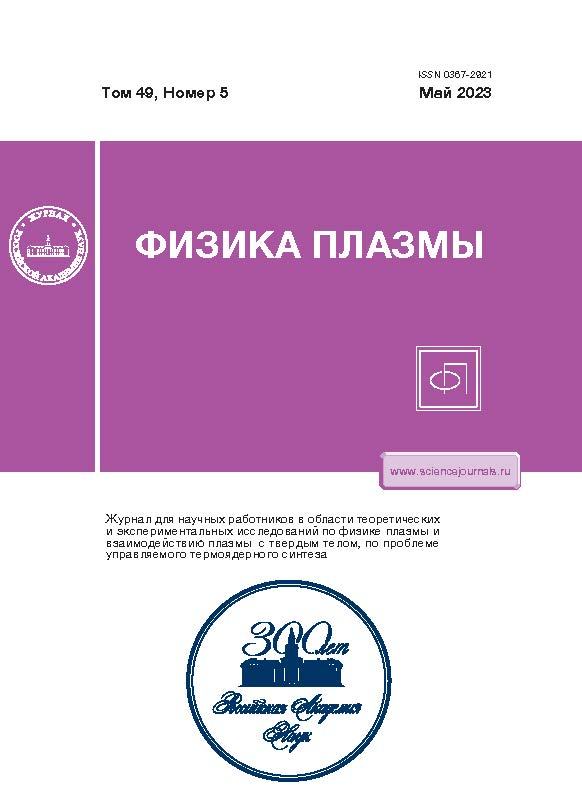Transformation of Condensed Matter into a Low-Temperature Plasma Flow for Problems of Plasma Mass Separation with a Potential Well
- 作者: Antonov N.N.1, Liziakin G.D.1, Vetrova S.B.2, Melnikov A.D.2
-
隶属关系:
- Joint Institute for High Temperatures of the Russian Academy of Sciences
- Joint Institute for High Temperatures, Russian Academy of Sciences
- 期: 卷 49, 编号 5 (2023)
- 页面: 471-475
- 栏目: LOW TEMPERATURE PLASMA
- URL: https://rjeid.com/0367-2921/article/view/668537
- DOI: https://doi.org/10.31857/S0367292123600188
- EDN: https://elibrary.ru/VFBFNZ
- ID: 668537
如何引用文章
详细
The concept of plasma mass separation of substances in a configuration with a potential well implies the creation of specialized plasma sources that comply with a number of requirements. The following can be distinguished as the main ones: a high degree of ionization of the plasma flow, single ionization, the possibility of working with a complex mixture of oxides and metals as a working substance, high productivity rate (up to 1 kg/h), kinetic energy at the level of several tens of electron-volts. One possible application of this concept is the separation of spent nuclear fuel. The conversion of condensed matter into a low-temperature plasma flow and its further injection into the separation chamber is the initial stage of the concept and it largely determines the efficiency of the technological process. This paper presents the results of studies of the energy distribution of lead ions in the plasma jet of a plasma source created on the basis of a non-self-sustained arc discharge with a hot cathode in a magnetic field. The influence of this distribution on the separation process was analyzed.
作者简介
N. Antonov
Joint Institute for High Temperatures of the Russian Academy of Sciences
Email: glizyakin@gmail.com
127412, Moscow, Russia
G. Liziakin
Joint Institute for High Temperatures of the Russian Academy of Sciences
Email: glizyakin@gmail.com
127412, Moscow, Russia
S. Vetrova
Joint Institute for High Temperatures, Russian Academy of Sciences
Email: antonovnickola@gmail.com
125412, Moscow, Russia
A. Melnikov
Joint Institute for High Temperatures, Russian Academy of Sciences
编辑信件的主要联系方式.
Email: antonovnickola@gmail.com
125412, Moscow, Russia
参考
- Zweben S.J., Gueroult R., Fisch N.J. // Phys. Plasmas. 2018. V. 25. P. 90901.
- Usmanov R.A., Amirov R.Kh., Gavrikov A.V., Lizia-kin G.D., Melnikov A.D., Polistchook V.P., Samoylov I.S., Smirnov V.P., Vorona N.A., Yartsev I.M. // Plasma Sources Sci. Technol. 2020. V. 29. P. 015004.
- Usmanov R.A., Amirov R.Kh., Gavrikov A.V., Lizia-kin G.D., Polistchook V.P., Samoylov I.S., Smirnov V.P., Vorona N.A., Yartsev I.M. // Phys. Plasmas. 2018. V. 25. P. 063524.
- Liziakin G., Oiler A., Gavrikov A., Antonov N., Smir-nov V. // J. Plasma Phys. 2021. V. 87. P. 905870414
- Liziakin G.D., Antonov N.N., Smirnov V.S., Timirkha-nov R.A., Oiler A.P., Usmanov R.A., Melnikov A.D., Vorona N.A., Kislenko S.A., Gavrikov A.V., Smirnov V.P. // J. Phys. D: Appl. Phys. 2021. V. 54. P. 414005.
- Smirnov V.S., Egorov R.O., Kislenko S.A., Antonov N.N., Smirnov V.P., Gavrikov A.V. // Phys. Plasmas. 2020. V. 27. P. 113503.
- Dolgolenko D.A. Muromkin Y.A. // Phys.-Usp. 2017. V. 60. P. 994.
- Rafalsky D., Dudin S., Aanesland A. // Rev. Sci. Instrum. 2015. V. 86. P. 053302.
- Simpson J.A. // Rev. Sci. Instrum. 1961. V. 32. P. 1283.
- Zhil'tsov V.A., Kulygin V.M., Semashko N.N., Skovoro-da A.A., Smirnov V.P., Timofeev A.V., Kudryavtsev E.G., Rachkov V.I., Orlov V.V. // Atomic Energy. 2006. V. 101. P. 755.
- Usmanov R.A., Antonov N.N., Gavrikov A.V., Lizia-kin G.D., Melnikov A.D., Oiler A.P., Smirnov V.P., Timir-khanov R.A., Volkov L.S., Vorona N.A. // Plasma Sci. Technol. 2022. V. 24. P. 085504.
- Murzaev Y., Liziakin G., Gavrikov A., Timirkhanov R., Smirnov V. // Plasma Sci. Technol. 2019. V. 21. P. 45401.
- Antonov N., Liziakin G., Usmanov R., Gavrikov A., Vorona N., Smirnov V. // Phys. Plasmas. 2018. V. 25. P. 123506.
补充文件















